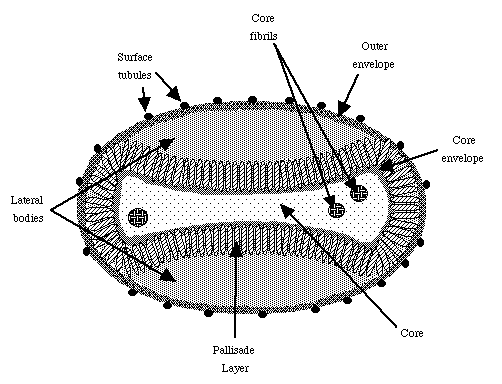
(Image courtesy of Leicester University, Department of Microbiology & Immunology)

(Image courtesy of
Leicester University, Department of Microbiology & Immunology)
 Introduction
Introduction
Welcome to my Pox Virus page! This website was constructed for a class at
Stanford University called
Human Biology
115: Humans
and Viruses, taught by Dr. Robert Siegel.
Click
here for links to web sites about other human virus families.
The focus of this page is on small pox, which, from the beginning of
history, caused devastating epidemics worldwide. However, in October
1977, after vigorous efforts by the World
Health Organization, this disease became the first ever to be
completely eradicated.
 Classification
and Taxonomy
Classification
and Taxonomy
Pox viruses are the largest and most complex of all
viruses. In fact, they are large enough, with a virion size of 220-350 x
115-260 nm, to be seen under a light
microscope. They infect a wide range of hosts, and are divided into two
subfamilies: Chordopoxvirinae and Entomopoxviridae. All human pox viruses
are in the Chordopoxovirinae subfamily, and most of them belong to either
the Orthopoxvirus (variola, vaccinia, cow pox) or the Parapoxvirus (Orf
virus) genus.
The chicken pox virus does not belong this family! - It is a
herpesvirus.
 Transmission
Transmission
Pox viruses are most commonly spread by direct contact. In the case of small pox, the virus is found in lesions in the upper respiratory tract, which can be transmitted to others in droplet secretions, and in skin lesions. Although the virus is considered to be highly contagious, this route of transmission makes its spread relatively slow.
 Immune Response and
Host Defenses
Immune Response and
Host Defenses
Infection by a pox virus results in cell-mediated immunity. People who are infected with small pox are generally immune to the disease for the rest of their lives.
 Useful Web Links
Useful Web Links
Still interested in finding out more about pox
viruses?
Interested in other viruses?
 References
References
Created by Jennifer Yuan, Human Biology, Class of 1998
Stanford University, Stanford, CA
Last modified: February 17, 1999